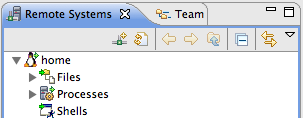Notice: this Wiki will be going read only early in 2024 and edits will no longer be possible. Please see: https://gitlab.eclipse.org/eclipsefdn/helpdesk/-/wikis/Wiki-shutdown-plan for the plan.
Compiling and Running the Parallel Ocean Program using Photran 5.0, PTP 3.0, and RDT
This tutorial will walk the user through setting up a photran project with standard makefile with PTP and RDT. The program we will use for this is the Parallel Ocean Program, whose source is freely available from http://climate.lanl.gov/Models/POP/.
Assumptions: I will assume that Photran, PTP, and RDT (and RSE) are already installed. For instructions on installing these, consult the respective project pages.
Configuring POP:
1. Download the newest version of the POP source code (2.0.1 at the time of this writing).
2. Extract this file on your remote system in the desired project location.
3. cd into the directory where you extracted pop
4. Run ./setup_run_dir test test. This copies the necessary files for testing in the test directory. Refer to the user manual at http://climate.lanl.gov/Models/POP/UsersGuide.pdf if you want to use a non-testing setup.
Configuring RDT:
1. Change to the Remote System Explorer perspective.
2. On the left side of the screen, look for something similar to the following:

3. Click on the new remote connection icon ![]() .
.
4. In the wizard that pops up, select the type of connection you need. For the purpose of this tutorial, we will assume the remote machine uses Linux.
5. On the next page, enter the hostname of the remote machine and a name for the connection.
6. The rest of the default settings should be sufficient, so click Finish.
7. Find the connection you created on the list. Make sure it is expanded (like in the screenshot above) and right click on Files, and then click Properties.
8. Select Server Launcher Settings and make sure this reflects how you plan to run the RDT server on the remote machine. This tutorial will assume you are using a "running" server.
9. Select Subsystem and make sure the port is set to the server port and the user id is your username on the remote host. Click OK.
10. Find the connection you created on the list. Right click on Ssh Terminals, and then click Properties.
11. Click Subsystem and make sure the port is set to the ssh port and the user id is your username on the remote host. Click OK.
12. On the remote machine, start the server by entering the directory and typing perl server.pl [port] where port is the port number you want the server to be running on.
13. Right click on the connection you created. Click Connect. You should now be connected to the remote machine.
At this point you should be connected to your remote machine. Make sure you can browse the remote machine's files before moving to the next step. (To browse the files, in the Remote System Explorer perspective, expand your connection -> Files -> My Home and make sure your home directory files are appearing.)
Creating a Remote Project:
1. Go to File -> New -> Project.
2. Expand the Remote category and select New Remote C/C++ Project. Click Next.
3. Type in a name for the project.
4. Uncheck Use default location.
5. Change the file system from default to RSE and click Browse.
6. Set the Connection to the connection you created previously.
7. Expand My Home and find the directory you extracted POP to. Select it and click OK.
8. Click Next until you get to the Configure Services dialog.
9. Change the Build provider to RDT Remote Build Service. Click Configure.
10. Change the Provider to RSE
11. Change Connection to the connection you created previously. Click OK.
12. Change the C/C++ Indexing Provider to RDT Remote C/C++ Indexing Service. Click Configure.
13. Change the Host to the connection you created previously. Click OK.
14. Click Finish. You should now be able to find the project you created in the C/C++ Perspective.
Configuring the Project:
1. Switch to the C/C++ Perspective.
2. Right click on the project and then click Properties.
3. Click C/C++ Build and change the Build directory field to the path to pop/test on your remote machine. (Ex: /home/rdt-test/pop/test)
4. Expand the C/C++ Build tree and select Environment. Click Add to add an environment variable with the name ARCHDIR and the value linux. Click OK.
5. Click OK in the project properties window to save your changes.
At this point, you should be able to successfully build and clean the project. If you cannot do this, check the following things:
1. The server is running and you have connected to it in the Remote System Explorer perspective.
2. Your build path is correct.
Creating a Resource Manager: In order to run your parallel program remotely, a remote resource manager must be created.
1. Switch to the PTP Runtime Perspective.
2. Right click in the Resource Managers box and click Add Resource Manager....
3. Choose the resource manager type according to how you plan to run the application on the remote machine. For the purpose of this tutorial, we will use OpenMPI.
4. On the next page, change the remote service provider to RSE and change the connection to the one you created previously. Then click Finish.
5. The resource manager should now show up on the list. Right click on it and then click Start Resource Manager.
If all goes well, the resource manager will start without a problem. If you get a message saying the resource manager could not be started or an internal error: null argument, remove and create the resource manager again. Be sure to leave the settings default.
(This tutorial is still being written)
